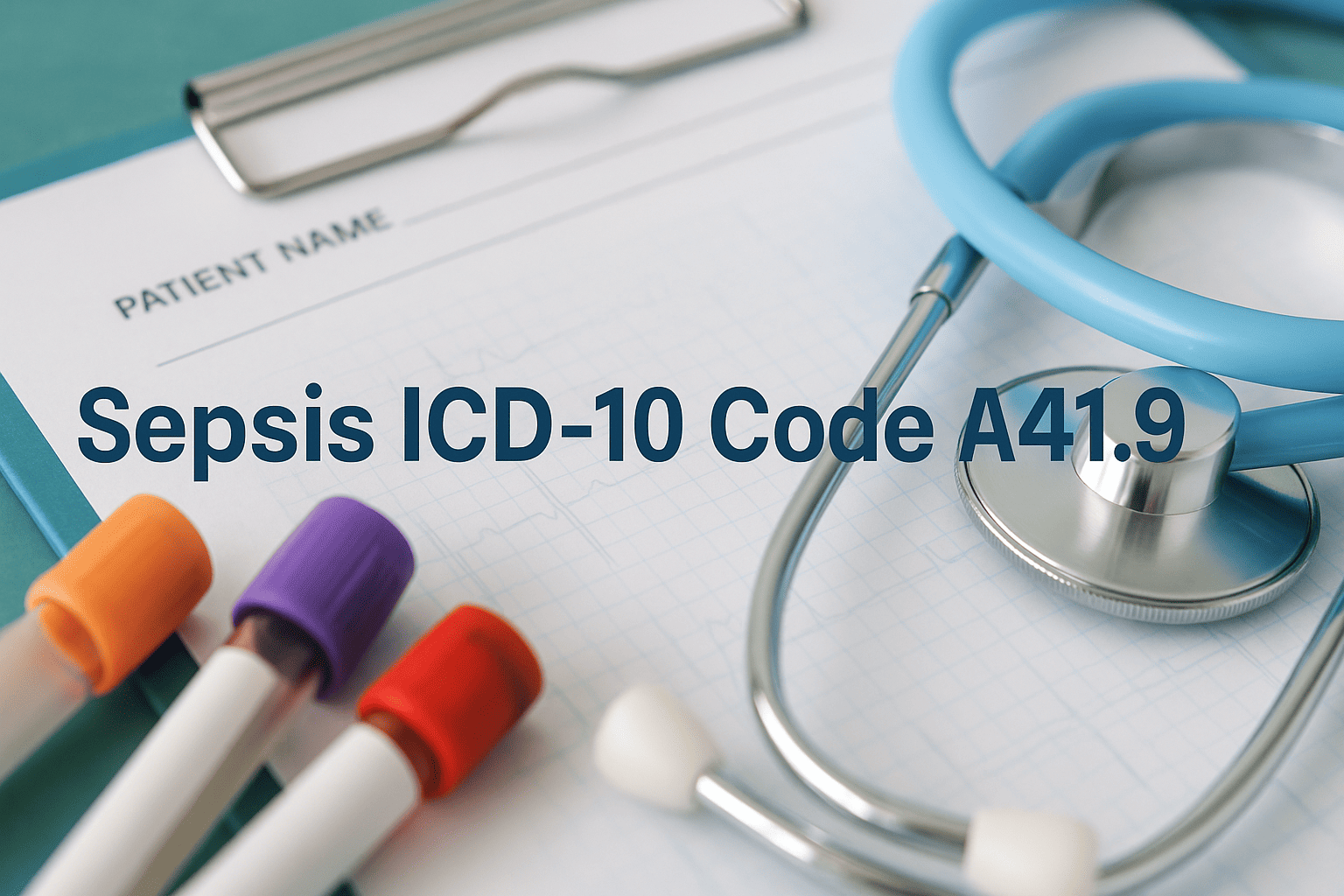Updated on: July 23, 2025
What is Sepsis?
Sepsis is a life-threatening, dysregulated immune response to infection that can lead to organ dysfunction, shock, and even death if not promptly recognized and treated. It often arises from infections in the lungs, urinary tract, skin, or abdomen and requires immediate medical intervention.
Understanding ICD-10 Code A41.9
A41.9 is used when sepsis is confirmed clinically but the causative organism is not specified in documentation or lab results.
This code includes:
-
Sepsis NOS (Not Otherwise Specified)
-
Septicemia NOS
-
Infection with systemic inflammatory response (no organism identified)
✅ Use A41.9 only when a systemic infection is diagnosed but the pathogen is unknown.
When NOT to Use A41.9
If a specific microorganism is identified, use one of the specific sepsis codes instead:
| Organism Identified | ICD-10 Code |
|---|---|
| Streptococcus, unspecified | A40.9 |
| Staphylococcus aureus | A41.01 |
| Escherichia coli (E. coli) | A41.51 |
| Anaerobic organisms | A41.4 |
| Clostridium difficile | A04.7 |
Common Clinical Features of Sepsis
Clinicians should document at least 2–3 of these clinical indicators to support coding:
-
Fever or hypothermia
-
Tachycardia
-
Tachypnea
-
Altered mental status
-
Elevated lactate
-
Hypotension or vasopressor need
-
Signs of organ dysfunction (e.g., elevated creatinine, jaundice, ARDS)
Sepsis Coding and Documentation Tips
Correct use of A41.9 requires:
-
Clear documentation of “sepsis” (not just “infection” or “bacteremia”)
-
Absence of a specific causative organism
-
Associated symptoms and site of infection (if known)
-
Treatment initiated (antibiotics, fluids, ICU transfer, etc.)
Example of Clear Documentation:
“Patient admitted with hypotension, fever, confusion. Blood cultures pending. Presumed sepsis secondary to urinary tract infection. Started on broad-spectrum antibiotics. Diagnosis: Sepsis (organism unspecified) – A41.9.”
How to Sequence A41.9 with Other Diagnoses
-
A41.9 should generally be the primary diagnosis if sepsis is the reason for admission.
-
Code the source of infection (e.g., UTI, pneumonia) as a secondary diagnosis, if documented.
-
Do not code systemic inflammatory response syndrome (SIRS) separately if sepsis is diagnosed — it’s already included in the sepsis definition.
Example ICD-10 Combination:
| Diagnosis | ICD-10 Code |
|---|---|
| Sepsis (unspecified) | A41.9 |
| UTI as infection source | N39.0 |
| Acute kidney injury | N17.9 |
Clinical Workflow for Sepsis Diagnosis
-
Initial signs: Fever, tachycardia, hypotension, altered mental status
-
Labs & Imaging: CBC, lactate, cultures, creatinine, chest X-ray
-
Initiate treatment: Broad-spectrum antibiotics, IV fluids
-
Identify infection source: Pneumonia, UTI, catheter site, wound
-
Document time and response to interventions
Having a virtual medical scribe like DocScrib can ensure that all these steps are thoroughly and correctly documented for billing and compliance.
Importance of Early and Specific Documentation
Sepsis is a high-stakes condition—both clinically and financially. Delayed or vague documentation can result in:
-
Claim denials
-
Lower DRG reimbursement
-
Medical-legal risks
-
Coding audits
How DocScrib Helps in Sepsis Documentation
DocScrib’s AI scribe system captures key data during the encounter:
-
Flags missing elements (e.g., vitals, infection site)
-
Suggests appropriate ICD-10 codes like A41.9
-
Tracks progression from SIRS → Sepsis → Septic Shock
-
Automates timestamping for sepsis bundles (CMS Sepsis Core Measures)
👉 Discover DocScrib’s AI-powered scribe platform
Reimbursement & CMS Core Measures
-
Sepsis is part of CMS SEP-1 quality measures
-
Accurate documentation improves hospital scores and risk-adjusted metrics
-
Misuse of sepsis codes can trigger audits or miss expected reimbursement
Coders and CDI teams should review sepsis cases daily to ensure A41.9 is used only when justified by clear documentation.
Frequently Asked Questions
Can I use A41.9 if cultures are pending?
Yes — if clinical judgment supports sepsis and no organism is yet identified.
Can A41.9 be paired with septic shock?
Yes. Use R65.21 (Severe sepsis with septic shock) as an additional code. Sequence A41.9 first.
What’s the difference between bacteremia and sepsis?
Bacteremia (R78.81) is the presence of bacteria in blood without systemic response. Sepsis includes infection plus systemic illness and organ dysfunction.
Conclusion
ICD-10 Code A41.9 plays a critical role in accurately capturing sepsis cases where the causative organism is unknown. Given its high-risk profile, correct documentation, sequencing, and coding are essential for compliance, patient safety, and hospital reimbursement. AI medical scribe tools like DocScrib can ensure sepsis is never under-documented — even in the most chaotic ER environment.
Want to automate and error-proof your sepsis documentation?
👉 Book a free DocScrib demo now
